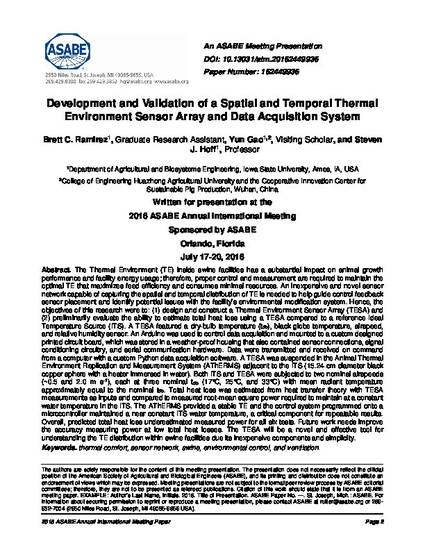
The Thermal Environment (TE) inside swine facilities has a substantial impact on animal growth performance and facility energy usage; therefore, proper control and measurement are required to maintain the optimal TE that maximizes feed efficiency and consumes minimal resources. An inexpensive and novel sensor network capable of capturing the spatial and temporal distribution of TE is needed to help guide control feedback sensor placement and identify potential issues with the facility’s environmental modification system. Hence, the objectives of this research were to: (1) design and construct a Thermal Environment Sensor Array (TESA) and (2) preliminarily evaluate the ability to estimate total heat loss using a TESA compared to a reference Ideal Temperature Source (ITS). A TESA featured a dry-bulb temperature (tdb), black globe temperature, airspeed, and relative humidity sensor. An Arduino was used to control data acquisition and mounted to a custom designed printed circuit board, which was stored in a weather-proof housing that also contained sensor connections, signal conditioning circuitry, and serial communication hardware. Data were transmitted and received on command from a computer with a custom Python data acquisition software. A TESA was suspended in the Animal Thermal Environment Replication and Measurement System (AThERMS) adjacent to the ITS (15.24 cm diameter black copper sphere with a heater immersed in water). Both ITS and TESA were subjected to two nominal airspeeds (~0.5 and 2.0 m s-1), each at three nominal tdb (17°C, 25°C, and 33°C) with mean radiant temperature approximately equal to the nominal tdb. Total heat loss was estimated from heat transfer theory with TESA measurements as inputs and compared to measured root-mean square power required to maintain at a constant water temperature in the ITS. The AThERMS provided a stable TE and the control system programmed onto a microcontroller maintained a near constant ITS water temperature, a critical component for repeatable results. Overall, predicted total heat loss underestimated measured power for all six tests. Future work needs improve the accuracy measuring power at low total heat losses. The TESA will be a novel and effective tool for understanding the TE distribution within swine facilities due its inexpensive components and simplicity.
Available at: http://works.bepress.com/steven_hoff/147/

This proceeding is published as Ramirez, Brett C., Yun Gao, and Steven J. Hoff. "Development and Validation of a Spatial and Temporal Thermal Environment Sensor Array and Data Acquisition System." In 2016 ASABE Annual International Meeting, Paper No. 162449936. American Society of Agricultural and Biological Engineers, 2016. doi: 10.13031/aim.20162449936. Posted with permission.